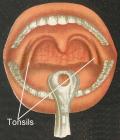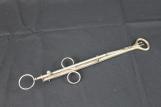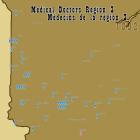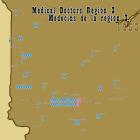1
Institutional medicine in central New Brunswick developed rapidly in the few decades following the Second World War. At its heart was the growth of hospitals and an understanding that medicine was best practised by a team of caregivers, and that hospitals were places of treatment and recovery rather than imprisonment or death.There were small cottage hospitals in Stanley and Fredericton in the late nineteenth century. Lady Tilley founded the 14 bed Victoria Hospital (VPH) in Fredericton 1887. Five years later a nursing programme was established. The hospital expanded piecemeal over the next half century, notably with the addition of the Fraser hospital in 1921, and by 1945 contained 130 beds. At that time, there were also small hospitals in Minto and Harvey.
Key to the transition to institutional medicine was the Federal Health Programme, which New Brunswick joined in 1948. Under the Programme, most capital equipment costs were shared between the two governments. Over the next two decades, new cottage hospitals were built in Stanley, Fredericton Junction, McAdam, Harvey and Oromocto, and a sizeable addition was made to the VPH. In 1955, at the urging of Dr. Everett Chalmers and other physicians in the province, including Dr. McInerney, the then minister of Health, the provincial Polio Hospital was opened in Fredericton. Four years later, Stan Cassidy promoted the construction of the provincial Rehabilitation Centre in the city.
2
Victoria Public Hospital1890-1920
Fredericton, New Brunswick, Canada
 Credits:
Credits:Provincial Archives of New Brunswick Gillian Liebenberg Polio Years 1941-1954 collection: P384-96
3
The Health Programme also funded medical clinics. In 1948, Everett Chalmers and Arthur VanWart opened the Fredericton Cancer Clinic that soon provided free diagnostic and treatment services. By 1955, the Mental Health Clinic opened in the city.In 1959, the province introduced a hospital insurance programme cost shared with Ottawa. This provided universal access to hospital services. The province took control of the hospitals and organized them into health regions each with a regional hospital capable of providing a wide range of medical services. Fredericton became the centre of a health region extending from Gagetown to Plaster Rock with the VPH as its regional hospital.
Around this time, physicians were starting to perform routine procedures such as tonsillectomies in a more organized manner. In some cases, a group of children in a community were rounded up and physicians would perform tonsillectomies on all of them. Tonsil were removed as a standard procedure since they could easily become infected and no known use for them existed. Removing the tonsils eliminated the possibility of a child having tonsillitis which is treated with antibiotics today.
4
Throat Plate #5 "Normal appearance of the pharynx, uvula and folds of the palate"Late 19th Century
 Credits:
Credits:Printed in the "Our Home Physician" manual from late nineteenth century
5
TonsillotomePost Modern, 1910-1950
Fredericton, New Brunswick, Canada
 Credits:
Credits:York Sunbury Historical Society collection 1981.7.25
6
Science long played a part in the prevention of communicable diseases such as smallpox and diphtheria. By 1972 antibiotics, imaging technologies (x ray, CAT scans) and laboratory tests of human fluids and tissues forever changed the face of medical practice. Most of this work was carried out in hospitals.In 1953, a Provincial Laboratory was established at the VPH. As lab tests became the foundation for medical diagnosis, the number of specimens processed rose dramatically. At the end of the Second World War, fewer than 100,000 specimens were examined for the whole province. By 1980, there were 1,262,000 tests at the Fredericton lab alone including 47,000 tissue biopsies.
Labs, cancer and mental health clinics, and polio, rehab and radiology centres required a large number of medical specialists. Surgery increasingly became a specialized function. Pathologists, surgeons, radiologists, OBGYN (obstetrics and gynaecology), ophthalmologists and internists, some certified, some specialized, became the norm in medical practice. By 1975 nearly half of all doctors in the Fredericton health region were specialists many of them on salary. After the introduction of Medicare, even general practitioners were drawn into the hospital's Emergency Room.
7
X-Ray Clockearly 20th Century
Fredericton, New Brunswick, Canada
 Credits:
Credits:York Sunbury Historical Society collection 1969.3493.1b
8
The institutional expansion produced an army of health workers in the region. Nursing staff grew to meet the new hospital needs with BNs and RNAs joining the traditional RNs. So too did dieticians, nursing assistants and ambulance workers. There were also an array of workers representative of the new skills and sciences, notably physiotherapists and lab radiation technicians.In 1971 New Brunswick joined the federal Medicare Programme which was 80% funded by Ottawa. Some 520 New Brunswick physicians opted into the programme while one did not. Medical care in central New Brunswick had become a universal public service.
Changes in medical care in the generation following 1945 produced some impressive results. Of every thousand babies born in York and Sunbury counties in the 1940s, 53 died shortly after birth. By the 90s, that rate had fallen to seven. In the same period, death rates from heart disease fell and maternal deaths fell to virtually nothing.
9
Distribution of Physicians in Region 3Circa 1892
New Brunswick, Canada
 Credits:
Credits:Fredericton Region Museum, "From Black Bag to High Science"
10
Distribution of Physicians in Region 3Circa 1953
New Brunswick, Canada
 Credits:
Credits:Fredericton Region Museum, "From Black Bag to High Science"
11
ReferencesYork Sunbury Historical Society. "From Black Bag to High Science." Officers' Quarters 28 no.2, Special Exhibits Edition (2011).